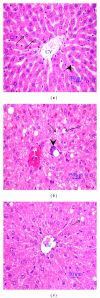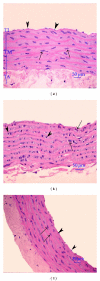Lipid-lowering and antioxidative activities of aqueous extracts of Ocimum sanctum L. leaves in rats fed with a high-cholesterol diet
- PMID: 21949899
- PMCID: PMC3178181
- DOI: 10.1155/2011/962025
Lipid-lowering and antioxidative activities of aqueous extracts of Ocimum sanctum L. leaves in rats fed with a high-cholesterol diet
Abstract
The present study was conducted to investigate the lipid-lowering and antioxidative activities of Ocimum sanctum L. (OS) leaf extracts in liver and heart of rats fed with high-cholesterol (HC) diet for seven weeks. The results shows that OS suppressed the high levels of serum lipid profile and hepatic lipid content without significant effects on fecal lipid excretion. Fecal bile acids excretion was increased in HC rats treated with OS. The high serum levels of TBARS as well as AST, ALT, AP, LDH, CK-MB significantly decreased in HC rats treated with OS. OS suppressed the high level of TABARS and raised the low activities of GPx and CAT without any impact on SOD in the liver. As for the cardiac tissues, OS lowered the high level of TABARS, and raised the activities of GPx, CAT, and SOD. Histopathological results show that OS preserved the liver and myocardial tissues. It can be concluded that OS leaf extracts decreased hepatic and serum lipid profile, and provided the liver and cardiac tissues with protection from hypercholesterolemia. The lipid-lowering effect is probably due to the rise of bile acids synthesis using cholesterol as precursor, and antioxidative activity to protect liver from hypercholesterolemia.
Copyright © 2011 Thamolwan Suanarunsawat et al.
Figures




References
-
- Freedman JE. High-fat diets and cardiovascular disease. Journal of the American College of Cardiology. 2003;41(10):1750–1752. - PubMed
-
- Badimon L, Vilahur G, Padro T. Nutraceuticals and atherosclerosis: human trials. Cardiovascular Therapeutics. 2010;28(4):202–215. - PubMed
-
- Kwiterovich PO., Jr. The effect of dietary fat, antioxidants, and pro-oxidants on blood lipids, lipoproteins, and atherosclerosis. Journal of the American Dietetic Association. 1997;97(supplement 7):S31–S41. - PubMed
-
- Vijayakumar RS, Surya D, Nalini N. Antioxidant efficacy of black pepper (Piper nigrum L.) and piperine in rats with high fat diet induced oxidative stress. Redox Report. 2004;9(2):105–110. - PubMed
Publication types
MeSH terms
Substances
LinkOut - more resources
Full Text Sources
Medical
Research Materials
Miscellaneous

